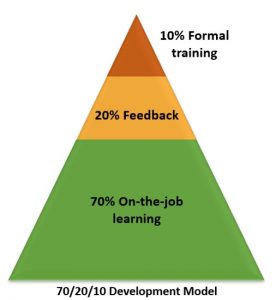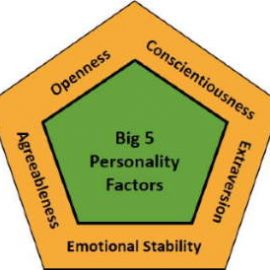
Employees learn best by trying new things on the job. Daily challenges and stretch assignments provide terrific on-the-job (OTJ) learning, and work gets accomplished at the same time.
OTJ learning connects many small pieces into powerful development.
Designing effective OTJ learning
How do you design an effective on-the-job learning experience for your team? How do you take advantage of one yourself?
In a previous post, we reviewed research by Seibert, Sargent, Kraimer and Kiazad (2017) that showed that OTJ learning provides the most effective leadership development.
In this post, we’ll build on that research to review the established 70/20/10 model of development and go deeper into the practicalities of setting up developmental job challenges.
70/20/10 Development model
As an established guideline in the training world, the 70/20/10 model of development refers to the recommended percentages of different types of learning.

For adult learners at work, the model recommends that 10% of development should be formal learning, 20% should be feedback and 70% should be on-the-job (OTJ) experiences.
Formal learning refers to classroom training, e-learning and workshops. Companies often default to formal learning when trying to teach new skills,. This model shows that only 10% of learning should happen that way.
Formal learning requires extensive money and time away from the job. In addition, learners often don’t remember the classroom lessons or apply them back at work.
Feedback makes up 20% of recommended learning. Feedback consists of coaching from the supervisor or other experts, assessments and mentoring. Feedback provides important developmental information, but it does not happen regularly.
As supported by the research, the 70/20/10 development model indicates that most learning (70%) should be through OJT experiences.
What is an OTJ learning experience (aka a developmental job experience)?

An OJT experience happens when learning occurs through daily work. The employee completes needed work but learns at the same time.
OJT experiences can be as simple as taking on new tasks and practicing to improve. They also encompass stretch assignments, cross-training, cross-departmental projects and committees, job shadowing and networking.
Although proven to be effective, OTJ experiences are harder to define and create than formal training. The benefits and challenges of them lie in the fact that they are unique and customized for each person and each situation.
6 dimensions of an OTJ learning experience
In their research article described in the eralier post, Seibert, Sargent, Kaimer and Kiazad highlighted 6 dimension of an OTJ experience (which they termed developmental job challenge).
Consider these elements when creating an experience for someone on your team.

- Unfamiliar responsibilities
- High levels of responsibility
- Creating change
- Managing boundaries
- Dealing with employee problems
- Managing diversity
These six dimensions encompass some of the elements that you can use to to stretch team members. Push them to learn new tasks and take on more responsibility.
Put them in charge of leading a change effort. Change efforts can be small like refining a process or large like rolling out a new program. Leading change teaches many leadership skills.
Leading projects can also teach leadership skills and how to deal with employee problems and diversity.
Setting up an OTJ learning experience
As a leader, you should always be looking for an opportunity to create an OJT experience for your team members. Some things to consider:

- Be intentional – Make a point of finding opportunities to stretch your direct reports. That might mean delegating some of your tasks to them. Although it might be quicker for you to do it yourself, it becomes a learning experience when delegated.
- Structure the experience – Be thoughtful about structuring the experience. As you assign the it, explicitly tell the employee that this is an OTJ experience and what skills you want them to learn. For example, the task might be to execute a task with another department, but the skill you want the employee to develop is about building collaborative relationships. Specify that as a key outcome.
- Monitor throughout – Keep track of the experience to provide guidance, support and feedback as needed.
- Debrief the learning – When complete, talk about the assignment. What worked and what did not. Remember to debrief the learning in addition to the outcome of the task.
How to navigate an OTJ learning experience
As an employee, take advantage of OTJ experiences when you get them. They are great opportunities for you to gain skills and visibility in your organization and to prepare you for broader career moves.

- Clarify expectations – When you get an OTJ experience assignment, confirm the intended outcome with your supervisor. Make sure you are aligned on what the task is and what additional learning is intended.
- Keep learning in mind along with the task – When caught up in executing a task, it is easy to forget the bigger picture. Slowdown as you go and reflect on your learning. Make sure you plan ahead. For example, if you are working on communication skills, you could ask a trusted colleague to watch you during a meeting and provide feedback afterwards.
- Investigate before seeking help – Learning on the job usually does not have as much support as you get in a training classroom. If you hit a roadblock, try to solve it by yourself – that is a key part of the learning. For instance, can you review similar work to look for clues or Google to find a solution.
- Ask for help when needed – If you have tried to find the answer and you are still stuck, ask for help! It’s okay to ask for help when learning something new.
- Debrief the learning – Check in with your supervisor to verify if you got the intended learning. You can also monitor your own learning through checkpoints or journaling.
Reference information
Seibert, S.E., Sargent L.D., Kraimer M., Kiazad, K. (2017) “Linking Developmental Experiences to Leader Effectiveness and Promotability: The Mediating Role of Leadership and Self-efficacy and Mentor Network”, Personnel Psychology, Vol 70, 357-397.
Discussion of Seibert etl al research on leadership development effectiveness posted on Science of Working on Oct 10, 2019 as “Invest in self-confidence to develop effective leaders“.



